i have forever been thinking of making up a small hunting knife set, and i keep on coming across tod's stuff and his bauernwehr sets. but now I'm looking for a little more information about them, not tod's reproductions, just bauernwehr's in general.
by a few wed searches i find that the nagel is the central design feature and limited (if any) guillions. I'm looking for what kind of cross section may have been found on these big blades, a flat grind or something else.
These knives come in several styles and sizes. They vary both over area and time.
There are sub types or cousins as well.
The Rugger for example has a long and narrow blade with a thick back.
The large ones have blades that are some 45 - 65 cm long.
They can have a straight back, or a mild curve like a saber. They can also have a mild drop point shape. It is common to see a rather drawn out and sharp point, but some have a shorter belly in the point, making for what think is sometimes called a hatchet point.
Smaller ones are 15-20 cm long but there seems to be sizes anywhere in between these.
The guard is not much of a guard at all: more a bolster. As a rule it is made from two pieces of iron (hollow or solid) that are riveted to the base of the blade, forming a kind of bolster. The nagel goes through this bolster and is riveted on the inside of the knife.
The shaping of the bolster is one of the features that help dating the knife. Later examples have more of a scroll at the spur of the guard, while earlier examples are more plain with limited or no file work to decorate them.
Cross sections of these blades tend to be triangular that transitions into a nice and lean apple seed edge. The edge bevels go all the way from the back of the knife: no flat along the back. This triangular cross section also continues into the tang. The tang can have a fuller forged in to save weight and make the balance more blade oriented.
Grip slabs are bone, antler or sometimes wood on simpler examples. The slabs are often fastened with tubular rivets that are made from rolled up flat sheet of some copper alloy (brass or bronze being common) There can be a cap on the end of the grip. Either a curved flat strip of iron that is riveted in place with a narrow extension of the tang, or a more pommel like feature that is birds head shaped. Earlier examples have no pommel or the simpler strap end. Later examples can have more elaborate pommel caps.
Hope this helps.
There are sub types or cousins as well.
The Rugger for example has a long and narrow blade with a thick back.
The large ones have blades that are some 45 - 65 cm long.
They can have a straight back, or a mild curve like a saber. They can also have a mild drop point shape. It is common to see a rather drawn out and sharp point, but some have a shorter belly in the point, making for what think is sometimes called a hatchet point.
Smaller ones are 15-20 cm long but there seems to be sizes anywhere in between these.
The guard is not much of a guard at all: more a bolster. As a rule it is made from two pieces of iron (hollow or solid) that are riveted to the base of the blade, forming a kind of bolster. The nagel goes through this bolster and is riveted on the inside of the knife.
The shaping of the bolster is one of the features that help dating the knife. Later examples have more of a scroll at the spur of the guard, while earlier examples are more plain with limited or no file work to decorate them.
Cross sections of these blades tend to be triangular that transitions into a nice and lean apple seed edge. The edge bevels go all the way from the back of the knife: no flat along the back. This triangular cross section also continues into the tang. The tang can have a fuller forged in to save weight and make the balance more blade oriented.
Grip slabs are bone, antler or sometimes wood on simpler examples. The slabs are often fastened with tubular rivets that are made from rolled up flat sheet of some copper alloy (brass or bronze being common) There can be a cap on the end of the grip. Either a curved flat strip of iron that is riveted in place with a narrow extension of the tang, or a more pommel like feature that is birds head shaped. Earlier examples have no pommel or the simpler strap end. Later examples can have more elaborate pommel caps.
Hope this helps.
Yes Mr Johnsson very helpful indeed, with a lot of the images i was coming up with i saw things that looked more messer like, and to be honest, i wasn't sure if messer and bauernwehr were a term that represented the same thing. a simple mans blade.
the apple seed edge, tells me that this was a heavy cutter, not something to use for very fine cuts. something that presents a strong edge for getting through tough stuff.
a lot of the swords i would like to see recreated come from Albrecht Durer, and although he uses an artistic license in his work, pictured below is something i wish i could recreate. this may be hatchet point to the extreme, for a while i though this blade was pictured as broken, but if you pick out the soldiers sheath, it is also squared off.
i'm thinking that some of this grip design should go into what I'm hoping to build up.
 Attachment: 61.95 KB
Attachment: 61.95 KB
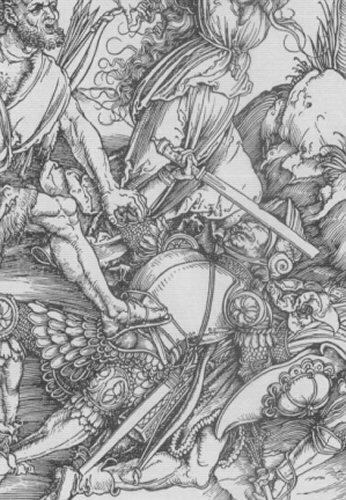
bauernwehr, messer, or just one cool looking chopper
the apple seed edge, tells me that this was a heavy cutter, not something to use for very fine cuts. something that presents a strong edge for getting through tough stuff.
a lot of the swords i would like to see recreated come from Albrecht Durer, and although he uses an artistic license in his work, pictured below is something i wish i could recreate. this may be hatchet point to the extreme, for a while i though this blade was pictured as broken, but if you pick out the soldiers sheath, it is also squared off.
i'm thinking that some of this grip design should go into what I'm hoping to build up.

bauernwehr, messer, or just one cool looking chopper
Daniel, if you go back to the board that featured Todd's work you may run into some more information the bauernwehr. The length and width of the blade can vary from a large butcher knife to something of sword dimensions Some could have bolsters or a short single branch guard. Either would have the nagel. If the knife had a double guard I would class it as a grossemesser.
I take it you have seen this?
http://www.myArmoury.com/talk/viewtopic.php?t=28308
http://www.myArmoury.com/talk/viewtopic.php?t=28308
| Daniel Wallace wrote: |
|
a lot of the swords i would like to see recreated come from Albrecht Durer, and although he uses an artistic license in his work, pictured below is something i wish i could recreate. this may be hatchet point to the extreme, for a while i though this blade was pictured as broken, but if you pick out the soldiers sheath, it is also squared off. i'm thinking that some of this grip design should go into what I'm hoping to build up. |
The blade in this Dürer drawing is an odd one. I am not sure how to classify it. It is so unusual you would have to stretch to call it a Bauernwehr. The name Bauernwehr means peasant´s defence after all. A simple, purposeful weapon that can be used for other things than violence.Perhaps it may be called a grossemesser.
Messer means knife.
Grossemesser means big knife.
In Italian there is Coltelaccio, mening big ugly knife. This is the root for Cutlass.
I have already mentioned the Rugger, that may be seen as a sub class of the bauernwehr.
You can say these weapons are related and you can see features that are shared among them, but I do not think there is a progression of development from one to the other in the group. Nor is there a siding scale of features or gradual mix of design details. What I am trying to get across is that these designs are similar but at the same time quite distinct.
We like to see the grossemesser as a sword-like knife, or a knife like sword with visible tang between riveted on grip scales. But there are many examples where the grip on messers have been covered with leather and sometimes even given a wire wrap. The blades are very varied from the very narrow and thick backed to the very wide and thin. They can be completely plain without any fullers or groves or much refined with groves, fullers and decorative complex grinds.
The Bauernwehr is also a varied group both in size and design, but they retain some character of being a big useful knife with a violent streak in its character. Much like the later Bowie knife.
What I said about apple seed edge must be understood as a relative thing. The edge can be robust but also quite fine. It will depend on the size and mass of the blade, the ideas of the maker, the taste of the user and to some degree perhaps also the hardness of the blade.
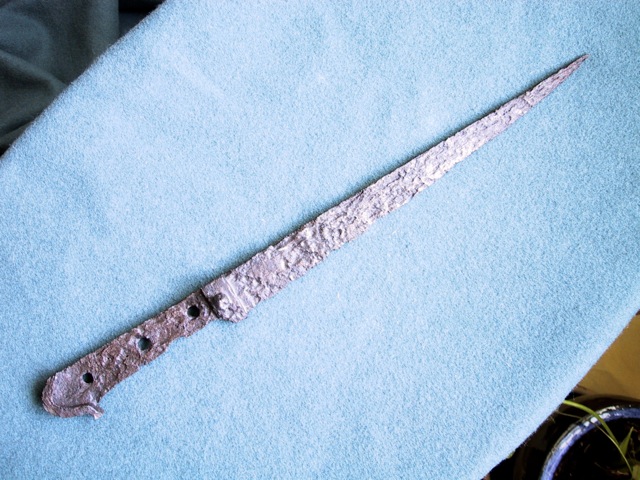
A 15th C rugger from a private collection
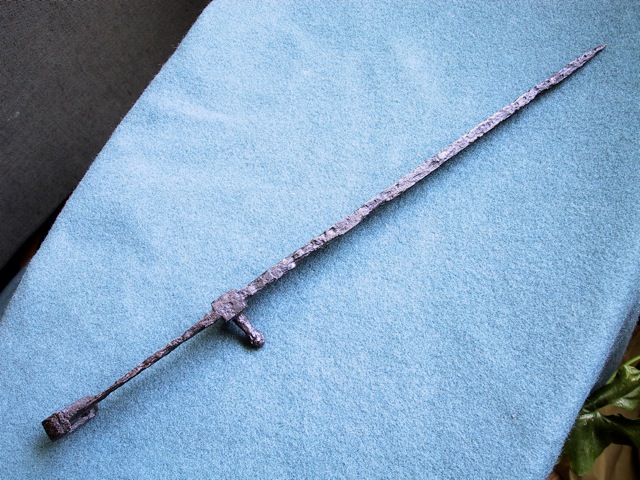
Narrow blade and very thick back
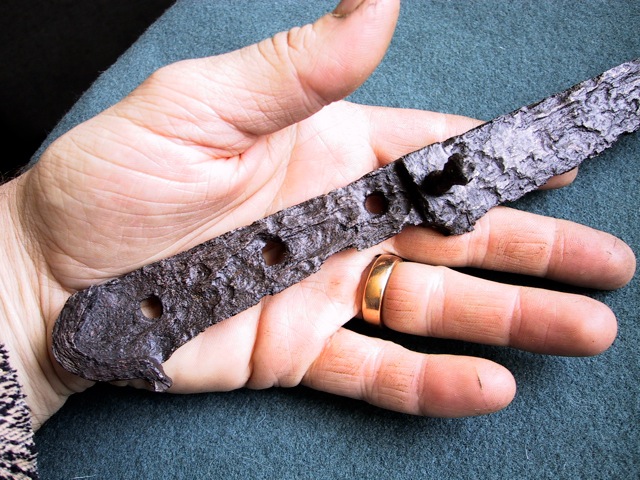
Handy size.
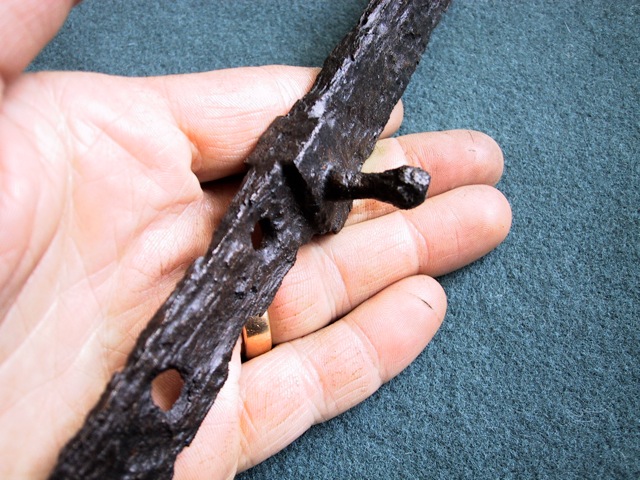
Nice nagel...

Three blades from Zürich. The right hand one is a Rugger. The mid one is 76 cm long in all. Lefthand one is 59 cm long, 16 C.

A big bauernwehr. Probably early 16th century from Fricker.
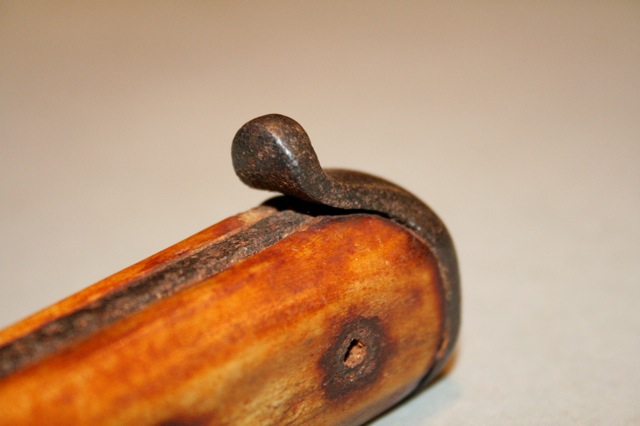
End cap is simply a curved strip of iron.
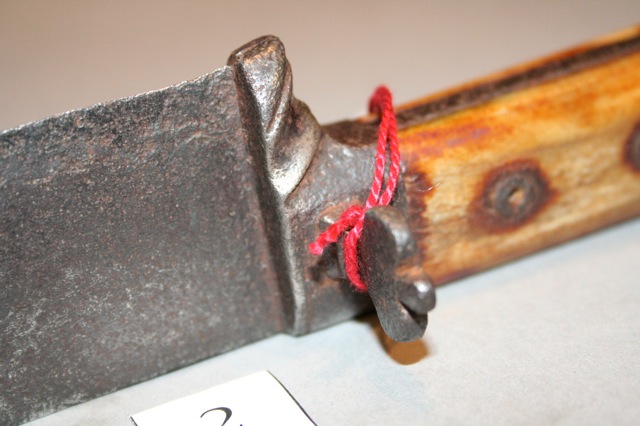
Bolster w. filework (helps with dating). Note the fine and thin edge on such a large knife.
thanks for all the reply's, i actually forgot about the recent DIY project that was here. that was some good work, hopefully i can keep at this project and make something respectable for my current abilities.
i like this idea behind the knife as Peter puts it "A simple, purposeful weapon that can be used for other things than violence" and "some character of being a big useful knife with a violent streak in its character." as I've had this project in mind I've always thought hunting kit.
anyway, yesterday i couldn't stop thinking up of a design concept. after about 15 minutes i came up on my first rendering of what i would like to attempt. it's simple, maybe not exactly a blade style you would see during the period, but i had simple big knife in my head as i penciled it out.
right now i just have my drawing and an idea - so how long it may take me to begin the project, we'll see as time allows. first its unfortunate but i cannot forge a blade at my shop, i just have no where to but a forge at this time. so i always look for suitable steel to rebuild with using stock removal method. if i had a forge, i would forge this thing out of D2 tool steel, I'd want it to be tough. consequently, i do not have that choice at the moment, so I'm going to fall onto a rebuild idea. out of what, I'll have to see what i can find at swap meat and flea markets. I'm going to keep my eye open for an old armed forces machete. it's big enough to cut up and have some steel to spare.
whatever stock i do find, I'd hope to make this big blade between 16 and 18 inches in length about an 1 1/4 at the base and widen out to 1 3/8. I'm also thinking of a rounded edge bevel to an apple seed edge very little distal taper, maybe just at the tip. a picker to go with it, probably just rounded, and a smaller knife with a thick spine and a fine hollow grind bevel and a nice gradual profile and distal taper for really fine cuts.
i'll probably make a full scale drawing sometime this week and see what elements i want to keep or remove. may not look 100% accurate for a period piece, but its inspired by a few ;)
 Attachment: 25.12 KB
Attachment: 25.12 KB

this is the first little concept i had, its drawn in with a small bevel on the back of the blade, i don't know if i'll keep the idea. and the nagel just a small simple clam shell.
i like this idea behind the knife as Peter puts it "A simple, purposeful weapon that can be used for other things than violence" and "some character of being a big useful knife with a violent streak in its character." as I've had this project in mind I've always thought hunting kit.
anyway, yesterday i couldn't stop thinking up of a design concept. after about 15 minutes i came up on my first rendering of what i would like to attempt. it's simple, maybe not exactly a blade style you would see during the period, but i had simple big knife in my head as i penciled it out.
right now i just have my drawing and an idea - so how long it may take me to begin the project, we'll see as time allows. first its unfortunate but i cannot forge a blade at my shop, i just have no where to but a forge at this time. so i always look for suitable steel to rebuild with using stock removal method. if i had a forge, i would forge this thing out of D2 tool steel, I'd want it to be tough. consequently, i do not have that choice at the moment, so I'm going to fall onto a rebuild idea. out of what, I'll have to see what i can find at swap meat and flea markets. I'm going to keep my eye open for an old armed forces machete. it's big enough to cut up and have some steel to spare.
whatever stock i do find, I'd hope to make this big blade between 16 and 18 inches in length about an 1 1/4 at the base and widen out to 1 3/8. I'm also thinking of a rounded edge bevel to an apple seed edge very little distal taper, maybe just at the tip. a picker to go with it, probably just rounded, and a smaller knife with a thick spine and a fine hollow grind bevel and a nice gradual profile and distal taper for really fine cuts.
i'll probably make a full scale drawing sometime this week and see what elements i want to keep or remove. may not look 100% accurate for a period piece, but its inspired by a few ;)

this is the first little concept i had, its drawn in with a small bevel on the back of the blade, i don't know if i'll keep the idea. and the nagel just a small simple clam shell.
Herman Historica has plenty of examples, you just need to some past auctions. As Mr Johnsson said, they could come in a variety of styles. Those long & narrow blades seem to appear mostly on earlier (to mid 16th century), and I have not seen them on larger Messer from 17th century (these are mostly called "Jagdmesser" - hunting tools more than personal weapons)
Just FYI, here is an interesting article I have obtained when discussing a similar issue on another forum. It´s in Czech, but has short intro in English and couple of wonderful pictures:
http://www.arsmaiorum.eu/Texty/Petr/Tesaky_s_...i_trny.pdf
And good luck with your project :)
Just FYI, here is an interesting article I have obtained when discussing a similar issue on another forum. It´s in Czech, but has short intro in English and couple of wonderful pictures:
http://www.arsmaiorum.eu/Texty/Petr/Tesaky_s_...i_trny.pdf
And good luck with your project :)
thanks for the article Radovan, i just flipped though the pictures and like the details shown.
i did jump over to Herman Historica after i read this post yesterday and saw a few blades that look like they have the same qualities I'm looking to represent in this blade. although they had big thick fullers and described as 'Waidblatt' i wasn't able to find any translation just to see what waidbatt discribed.
i did jump over to Herman Historica after i read this post yesterday and saw a few blades that look like they have the same qualities I'm looking to represent in this blade. although they had big thick fullers and described as 'Waidblatt' i wasn't able to find any translation just to see what waidbatt discribed.
Hi Daniel,
The term "waidblatt" breaks down to "waid" (Old German word for "hunt" ) and "blatt" which means "blade". Waidblatt and "waidpraxe" usually refer to the same kind of specialized knife, a hunters cleaver.
See this thread for a bit of discussion : http://www.myArmoury.com/talk/viewtopic.php?t=24669
I would consider them to be part of the messer/bauernwher family but they are specialized items, for carving up the carcass into packable chunks for the walk or horse ride home from the hunt.
I don't think they fit the role of general purpose use the way a more typical bauernwher does. They were often (if not nearly always) part of a kit we often refer to as a hunting trousse (which is a French term, I don't know what the German equivalent is) which combines the cleaver and a fork and smaller knife (and sometimes a pricker and another small knife, etc) into one sheath. Which is surely specialized enough to make it unlikely that you'd pack it around when you aren't hunting.
My two cents worth- smarter folks probably can tell you more.
The term "waidblatt" breaks down to "waid" (Old German word for "hunt" ) and "blatt" which means "blade". Waidblatt and "waidpraxe" usually refer to the same kind of specialized knife, a hunters cleaver.
See this thread for a bit of discussion : http://www.myArmoury.com/talk/viewtopic.php?t=24669
I would consider them to be part of the messer/bauernwher family but they are specialized items, for carving up the carcass into packable chunks for the walk or horse ride home from the hunt.
I don't think they fit the role of general purpose use the way a more typical bauernwher does. They were often (if not nearly always) part of a kit we often refer to as a hunting trousse (which is a French term, I don't know what the German equivalent is) which combines the cleaver and a fork and smaller knife (and sometimes a pricker and another small knife, etc) into one sheath. Which is surely specialized enough to make it unlikely that you'd pack it around when you aren't hunting.
My two cents worth- smarter folks probably can tell you more.
waidblatt, has much more of the correct meaning I'm thinking of in this design, i guess it doesn't really matter what i call the thing - as my design is not a recreation more of a inspiration, therefor its even harder to classify by blade type although the purpose remains the same.
i am still sticking with my first design concept, as I'm making this for me. but who knows i may change up a few things before i begin to cut on some steel.
i am still sticking with my first design concept, as I'm making this for me. but who knows i may change up a few things before i begin to cut on some steel.
Page 1 of 1
You cannot post new topics in this forumYou cannot reply to topics in this forum
You cannot edit your posts in this forum
You cannot delete your posts in this forum
You cannot vote in polls in this forum
You cannot attach files in this forum
You can download files in this forum
All contents © Copyright 2003-2006 myArmoury.com — All rights reserved
Discussion forums powered by phpBB © The phpBB Group
Switch to the Full-featured Version of the forum
Discussion forums powered by phpBB © The phpBB Group
Switch to the Full-featured Version of the forum